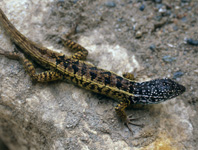Abstract
Three Neogobius species are common in the southern Caspian Sea. Identification of these species, especially from remains, is not fully understood. The present study compares the morphological characteristics of sagittal otoliths of N. caspius, N. pallasi and N. melanostomus. Furthermore, it also provides a dichotomous identification key based on otoliths morphology.
References
Bani, A., Poursaeid, S. & Tuset, V.M. (2013) Comparative morphology of the sagittal otolith in three species of south Caspian gobies. Journal of Fish Biology, 82, 1321–1332.
http://dx.doi.org/10.1111/jfb.12073.
Berg, L.S. (1949) Freshwater Fishes of the U.S.S.R. and Adjacent Countries. Izdatel'vesto Akademii Nauk SSSR, Moscow.
Kottelat, M. & Freyhof, J. (2007) Handbook of European freshwater fishes. Publication Kottelat, Cornol and Freyhof, Berlin, 646 pp.
http://dx.doi.org/10.1007/s10228˗007˗0012˗13.Neilson, M.E. & Stepien, C.A. (2009) Escape from the Ponto-Caspian: evolution and biogeography of an endemic goby species flock (Benthophilinae: Gobiidae: Teleostei). Molecular Phylogenetics and Evolution, 52, 84–102.
http://dx.doi.org/10.1016/j.ympev.2008.12.023.
Neilson, M.E. & Stepien, C.A. (2011) Historic cryptic speciation and recent colonization of Eurasian monkey gobies (Neogobius fluviatilis and N. pallasi) revealed by DNA sequences, microsatellites and morphology. Diversity and Distributions, 17, 688–702.
http://dx.doi.org/10.1111/j.1472-4642.2011.00762.x.Reist, J.D. (1985) An empirical evaluation of several univariate methods that adjust for size variation in morphometric data. Canadian Journal of Zoology, 63, 1429–1439.
http://dx.doi.org/10.1139/z85-213.
Rohlf, F.J. (2006) tpsDig2, digitize landmarks and outlines, version 2.10. Department of Ecology and Evolution, State University of New York at Stony Brook.
SPSS Inc. (2011) SPSS. Ver. 19.0. Base. Chicago, IL: SPSS, Inc.
Stransky, C. & MacLellan, S.E. (2005) Species separation and zoogeography of redfish and rockfish (genus Sebastes) by otoliths shape analysis. Canadian Journal of Fisheries and Aquatic Sciences, 62, 2265–2276.
http://dx.doi.org/10.1139/f05-143.Tuset, V.M., Lozano, I.J., Gonzalez, J.A., Pertusa, J.F. & Garcia-Diaz, M.M. (2003) Shape indices to identify regional differences in otolith morphology of comber, Serranus cabrilla. Journal of Applied Ichthyology, 19, 88–93.
http://dx.doi.org/10.1046/j.1439-0426.2003.00344.x.Tuset, V.M., Rosin, P.L. & Lombarte, A. (2006) Sagittal otoliths shape as useful tool for the identification of fishes. Fisheries Research, 81, 316–325.
http://dx.doi.org/10.1016/j.fishres.2006.06.020.
Tuset, V.M., Lombarte, A. & Assis, C. (2008) Otolith atlas for the western Mediterranean, north and central eastern Atlantic. Scientia Marina, 72, 1–198.
http://dx.doi.org/10.3989/scimar.2008.72s17.Vignon, M. (2012) Ontogenetic trajectories of otolith shape during shift in habitat use: Interaction between otolith growth and environment. Journal of Experimental Marine Biology and Ecology, 420, 26–32.
http://dx.doi.org/10.1016/j.jembe.2012.03.021Vignon, M. & Morat, F. (2010) Environmental and genetic determinant of otolith shape revealed by a nonindigenous tropical fish. Marine Ecology Progress Series, 411, 231–241.
http://dx.doi.org/10.3354/meps08651
Zar, J.H. (1999) Biostatistical Analysis, 4th ed. Upper Saddle River, NJ: Prentice-Hal

